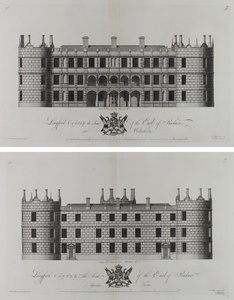| Method | Copper engraving |
| Artist | Tobias Martin Miller after Thomas Milton |
| Published | Built in 1591 repair'd & alter'd in 1717. T. Milton mensur et del. T. Miller sculp. 1766. [London, 1765-1771] |
| Dimensions | Images 250 x 475 mm, Plates 330 x 550 mm, Sheets 575 x 695 mm |
| Notes |
Titled in English and French. A finely engraved pair of architectural views of the facade and garden front of Longford Castle, Wiltshire, from the Woolfe and Gandon volumes of Vitruvius Britannicus, or, The British Architect. The plates record the structure as it was under the ownership of Sir Edward des Bouverie, before it was extensively remodelled by James Wyatt on behalf of the 2nd Earl of Radnor. Vitruvius Britannicus or, the British Architect. Containing the Plans, Elevations, and Sections of the most Regular Buildings both Publick & Private in Great Britain was the first architectural work to emerge from England since John Shute's The First and Chief Groundes of Architecture, which was first printed in 1563. Often regarded as a catalogue of designs, Vitruvius Britannicus contained a number of plans, elevations, and sections of buildings in Great Britain by the most prominent architects of the day, including Inigo Jones and Sir Christopher Wren. The text as well as a great many of the designs were the work of the Scottish architect Colen Campbell, with the first three volumes being published between 1715 and 1725. The success of Vitruvius Britannicus was instrumental in popularising neo-Palladian Architecture in Great Britain and America during the eighteenth century, and was one of the driving forces behind the development of Georgian architecture. The book inspired two significant imitators, both of whom borrowed the title for their own publications. The first, in 1739, was published by Badeslade and Rocque, but featured mostly topographical views. Between 1765 and 1771, the architects Woolfe and Gandon issued their own two volume set as Vitruvius Britannicus Volumes IV and V. In style, their publication was a much closer fit to the Campbell originals, and featured some of the finest examples of architecture to have appeared in the 40 years between the two books. Tobias Martin Miller, born Müller, (fl.1753-1804) was a German-born engraver who moved to England in the 1740s with his brother Johann Sebastian Müller, who was also a prolific engraver. Tobias Miller predominantly engraved architectural plates, contributing to most of the important architectural works of the late eighteenth century. Thomas Milton (fl.1760s-1770s) was an architectural draughtsman, who was possibly the prolific topographical engraver of the same name (c.1750-1827), though the life dates of the latter suggest he would have been too young to have been the same Thomas Milton who contributed drawings for the Woolfe and Gandon volumes of Vitruvius Britannicus. John Woolfe was an Irish draughtsman active in the latter half of the eighteenth-century. From the 1750s onwards, Woolfe was employed in the Office of Works. He was the joint author with James Gandon of volumes 4 and 5 of Vitruvius Britannicus. His son, of the same name, worked for the Office of Works between 1787 and 1806. Colen Campbell (1676-1729) was a Scottish architect and architectural writer, credited as a founder of the Georgian style. He is best known as the author of Vitruvius Britannicus. Condition: Central vertical folds, as issued. Minor time toning to folds. Minor creasing to plates. |
| Framing | unmounted |
| Price | £275.00 |
| Stock ID | 50860 |

